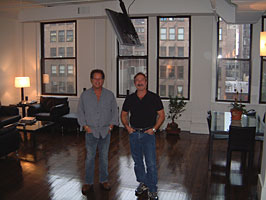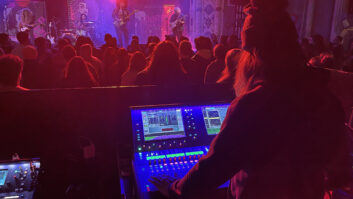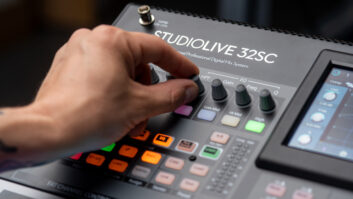
At Color: Jeff Rosner, executive producer (left) and Josh Abbey
Photo: David Weiss
The year 2006 is just a couple of notches back on the calendar, but in the lightning-fast world of New York City audio post, it’s more than enough time for a then-new facility to have come of age. With a writer’s strike (since settled), volatility in the national economy and the ever-present fast technological turnover, this segment of the entertainment industry is enough to put gray hairs on the heads of at least two members of New York City post’s Class of 2006.
Way back in July ’06, Color (www.color-ny.com) had just opened its doors, and for executive producer/partner Jeff Rosner and his then two-man crew of mixers Josh Abbey and Kevin Halpin, the business of audio post represented a fresh new adventure. “These guys were looking to do something different,” says Rosner, who himself would be going in a new direction after founding the renowned JSM Music and Sacred Noise music houses in prior decades. “They were great friends, two great music engineers I had always hired for orchestral or rock dates that my music company was doing. The music industry had changed for them a little, as well, and their particular talents seemed to be perfectly suited for the audio post mixing industry.
“I thought this was a perfect opportunity because of my connections and their reputations,” Rosner continues. “Even though we had never done this business before, we thought we could somehow pull it off and come in at a very high level, without having had clients that had worked with us in that capacity. It was sort of a gamble.”
Meanwhile, across town, Hobo Audio Company (www.hoboaudio.com) would be digging into its own mixes starting in October of that year — only in this case, gambling was not in the business plan. Founded by Howard Bowler — a former executive at Grey Advertising who managed its in-house post division, The Tape Center, for 10-plus years — Hobo was born out of the intense experience of answering daily to one extremely demanding mega-client. “It was an enormously useful training ground,” says Bowler. “There were so many different types of work that were thrown my way. In that type of environment, you learn to think very quickly and professionally — you do stuff fast, but it has to be right.
“By starting my own shop, I could mold a business in a way that I’m comfortable with. I don’t have a bureaucracy and the approvals I would have to go through in a company like this to make big decisions. So while we move quickly, we also move extremely carefully.”
While Rosner may never have run an audio post facility before Color, his experience from the music-house side taught him what areas to concentrate on at his current shop, which has hosted sessions for clients such as Toyota, the Marines, and PlayStation 3. “We didn’t want to jam things in here so that our clients wouldn’t feel that they have to get out the minute a session is done — instead, we created a buffer so that even if something was booked next, they wouldn’t feel like they were being dragged out of the room,” he explains. “Also, we made sure that we had a very tight after-session scenario. The mix coming out is crucial, and it needs to be handled by people we could have a lot of faith in; that’s what we found in Warrick Marais, who became the central hub to our situation here. There’s so many different methods of distribution, whether it’s cinema, HD, surround, stereo, etc. With so many complicated results that this can become, you want to make sure you can handle each one.”
Bowler agrees that the fast-growing choice of formats that post houses need to be prepared for has been an issue that’s on the top of his staff’s minds at all times. “It’s not that clients want their mixes executed in a new or different way, but for different formats the delivery is changing, with many different types of files and file sizes,” notes Bowler. “For example, we’re working on audio for an interactive educational Website, and they’ve got different requirements for the size and volume of the files a broadcast spot would have. We may have to normalize the files to a certain spec for the Website to make it blend it with what the current audio files are. The MP3 formats are ridiculously popular now, as well.”
Anyone opening an audio post house in 2006 also had some unique machine-room decisions to make when plotting the studio’s infrastructure. “The big decision was whether to be tapeless or not,” Bowler says. “We decided not to invest in any tape technology, not even DATs, because we felt that the trend is toward file sharing and digital technology. We wired the rooms for tape decks so if we had to relay to a DigiBeta, we could — I think once in the past year we rented a ¼-inch deck to do relays.”
At Hobo, whose clients include Verizon, Food Network and, yes, Grey Advertising, two mix suites (a third is in the works) are running Digidesign Pro Tools HD 7.3 connected to D-Command worksurfaces. “It’s funny how engineers are going full-circle, especially the younger ones,” says Bowler. “At the agency, I was basically mixing with a mouse, but it’s much faster and much more elegant to mix with a D-Command. It’s easier to write fader automation, and you can access the plug-ins off of a tactile surface. So it’s very much like a traditional console, and the guys are really fast on it.”
Everything old is also new again at the spaciously stylish headquarters of Color, where their mixers’ deep experience with recording and mixing orchestral music remains a major asset, according to Rosner. “Kevin mixed a classically scored Coke spot for Super Bowl XXII and the composer, Robert Miller, who I had worked with for years, knew of our strength with orchestral music,” he says. “He had recorded hundreds of spots where Kevin was the engineer on those dates, and he trusted Kevin’s ability to work with orchestral music. It turned out to be a complicated project, with extra stems and elements that Kevin mixed in. His ability to understand that made it incredibly important to have him there. It can never be a negative to feel comfortable with that genre, along with using other elements and voice-over. That’s why we thought we had a unique twist to add.”
Coming on two years of experience in the mean city streets under their tassels, New York City’s 2006 grads are clearly growing up fast as they survey the near future for local and national audio post. “I think that, as always, the great companies will emerge and maintain their status,” Rosner states. “There’s a lot in the viral world that needs to come up to speed — it’s like the stepchild of advertising where the budgets are smaller. But as clients understand how important it is — the campaign is on your computer and on your TV through your computer — it will expand the amount of work. I think the business will continue to grow, and the better companies will be the ones to go into the different media that agencies find themselves in.”
“The post scene right now is very competitive,” Bowler adds. “It’s very important to distinguish yourself, in a sense almost like a brand, but I don’t believe it has to be defined overnight. It’s a journey, defined by the choices you make and the clients you take on, and that under the umbrella of a terrific experience is what we have to offer our clients right now. We feel very strongly that clients enjoy the experience here, and maybe I’d say we’re kind of conventional here, except we don’t think along conventions. We go wherever the muse takes us, and we’re fearless in that regard.”
Send “Metro” news to [email protected].





